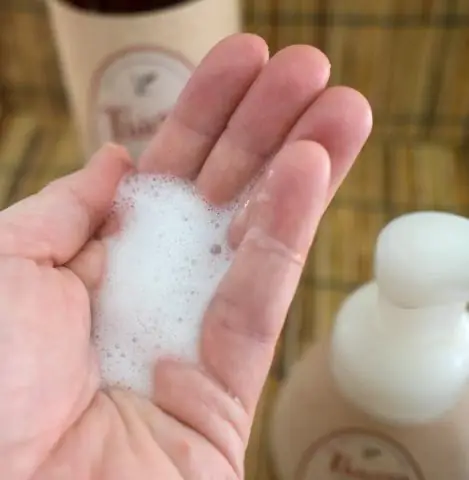
Table of contents:
- Author Bailey Albertson [email protected].
- Public 2023-12-17 12:53.
- Last modified 2025-06-01 07:32.
How to clean the multicooker from odors and dirt

In our time, a woman has too many worries: work, keeping the house clean, raising children and, of course, cooking. If both children and husband can help with putting things in order in the house, then it is better not to let them in the cooking process - they will not succeed so well. In order not to stand at the stove at night and cook, smart women buy multicooker - robots that cook food for a specified time according to given programs. A multicooker (multi-cooker) is an indispensable assistant in the kitchen, but, as in any container, it retains various odors that mix and sometimes give food an unpleasant aroma, even if the products were fresh. Also, food particles are retained in various parts of the multi-cook, from which mold can form. How to deal with this?
Content
- 1 The design of the multicooker
-
2 How often to wash the multicooker
- 2.1 Non-stick bowl
- 2.2 Protective shield
- 2.3 Housing
- 2.4 Condensate tank
-
3 Means for washing multicooker
3.1 Dishwasher safe
-
4 How to wash a multicooker: step by step instructions
- 4.1 Video: washing the multicooker
- 4.2 Different types of coatings
- 4.3 Different types of pollution
- 4.4 How not to do it
-
5 How to get rid of odors
- 5.1 Plastics
- 5.2 Rotten meat
- 5.3 Mixing odors or aroma of spices
- 6 Reviews
Multicooker design
The design of any multi-cook is quite simple:
- body; performs the function of thermal insulation, and it is also in it that all pressure and temperature sensors, a heating element, a control unit, and so on are located;
- non-stick cooking bowl; it can be removed, it is located inside the case;
- case cover; seals the unit from above, preventing the dispersion of liquids; there is at least one valve for steam release;
- valve (s) for steam release; there may be several of them, especially if the multicooker involves cooking under pressure; the valves are removable - it is quite easy to remove and install back; located on the protective screen;
- condensate reservoir.
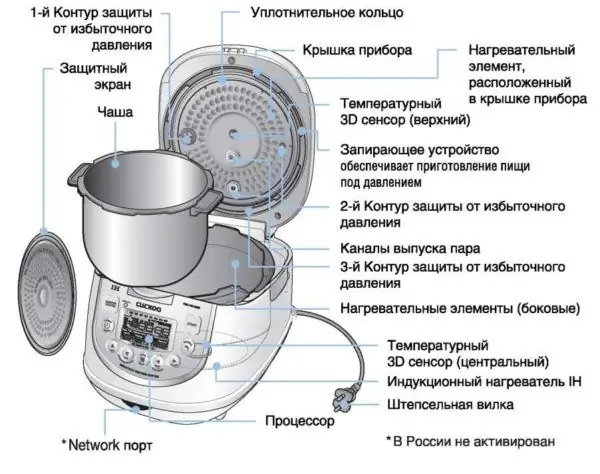
A multicooker is a fairly simple device to assemble, so removing parts for washing and installing them back will take a minimum of effort
How often to wash the multicooker
Each element of the multicooker must be washed at different intervals.
Non-stick bowl
Any dish is prepared in this bowl, therefore it must be washed after each preparation. It is important that not the slightest food particles remain, especially at the bottom, which is often corrugated.
Even from a small piece, mold can quickly appear and grow, since the multicooker is always at room temperature and humidity is quite acceptable for the appearance of rot. As you know, it is impossible to get rid of mold - its spores penetrate deep into any substance, so the reappearance of rot is only a matter of time.
All multicooker should have a special stewing stand. Depending on the model of the unit, this can be a stand on small legs, which must be installed on the bottom of the bowl, or a grate, which must be hung on the walls of the bowl. This stand, no matter how it looks, must also be washed after each use, especially carefully washing the holes in it: food particles can accumulate there, which inevitably leads to the formation of mold.
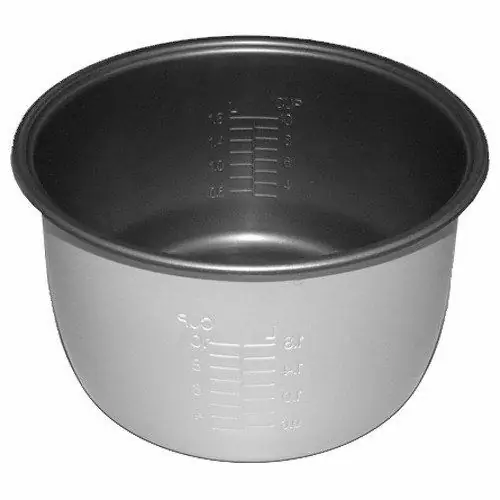
Despite the fact that the bowl is made of non-stick materials, food sometimes burns; in this case, the bowl must be washed immediately
Protective shield
Most multicookers work under pressure, which speeds up the cooking process at times. However, all condensate, together with food particles, accumulates on the protective screen and, after opening the lid of the multicooker, flows down to the body or into a special tank. The protective screen is used to prevent condensation from getting into the finished dish.
In the center of this screen there is an element (usually in the form of a ring) that holds the screen close to the lid. It must be unscrewed, holding the protective screen so that it does not fall. This ring should be washed as well as the screen itself, as grease particles accumulate on it.
The protective screen must be washed every 2-3 cooks, especially if these are dishes of different profiles, so that odors do not mix with each other. Since the smallest particles of food and grease accumulate under the lid, mold can develop there, so even for such reasons, the shield should be washed at least once a week.
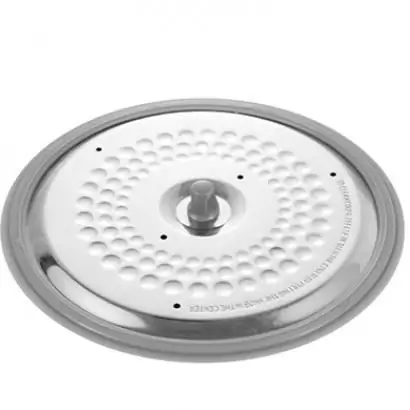
The protective screen is held by a special removable element in the center, so it must be removed very carefully
Housing
The case is less in contact with food, but still it should also be washed - both inside and out. The inside of the lid, which is in contact with the protective screen, needs to be washed as often as the screen itself, and the rest of the body can be washed once or twice a month.
Condensate tank
Some multicooker has a dedicated condensate tank located outside the cabinet on the back. When the lid is opened for the first time after cooking, all condensate flows down and falls either on the body, and from there into the tank, or directly into the tank. It also needs to be washed at least once a week as condensation contains various fats. If the water does not evaporate from the tank, it must be poured out yourself as soon as 3/4 is reached.
Means for washing multicooker
The multicooker requires special care for each of its elements. If everything is clear with the non-stick coating - if it is damaged, then the food will burn, then what about the materials of the rest of the machine parts? The screen protector is made of a special coating, damage to which can lead to the accumulation of odors and grease particles in the screen itself, and not under the cover. The body is made of other materials from the inside, which provide good heat conduction inside the bowl and keep it safe for a long time. Thus, damage to the surface layer of any element of the multicooker can lead to disruption of its operation.
To avoid this, you must:
- use only soft sponges (no hard side) and dish gels to wash the protective screen and bowl;
- use soft damp cloths to wash the multicooker body both inside and outside;
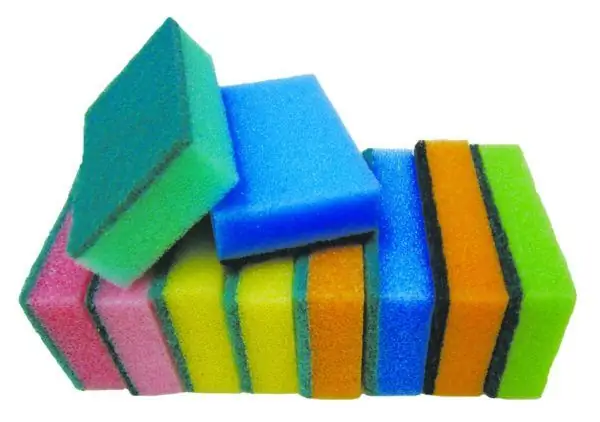
Some dish washing sponges have one hard side - it is better not to wash the multicooker with it at all, only the soft side
Under no circumstances should any harsh abrasive materials or powders be used to remove dirt from the multi-cooker. It is also strictly forbidden to use any solvents - the material will be damaged and cannot be restored.
An ordinary soft sponge or cloth, hand-gentle dishwashing gel and warm water are perfect for washing any element of the multicooker. Whatever the pollution, these materials will cope with it, however, a little more time may be spent than planned.
Dishwasher safe
It is not recommended to wash any part of the multicooker in the dishwasher, since the basis of all the elements of the multi-cooker is aluminum, which is corroded in dishwashers. This can be clearly seen on the handles of Teflon pans - here such damage is insignificant, but for a bowl from a multicooker or for a protective screen it can be critical. Of course, nothing will happen from one time, but you should not get carried away with it.
How to wash a multicooker: step by step instructions
If you wash the multicooker for the first time, you may forget to wash some very important element, which will subsequently cause a number of troubles. To avoid this, do the following:
-
The first step is to take out the non-stick bowl and wash it.

Washing the multicooker bowl with a silicone sponge The bowl can be washed with a regular foam or silicone sponge
-
Remove the protective shield from the inside of the lid and wash it in the same way as the bowl. In some models of multicooker, the protective screen is held by a special twisting element, on which grease can also accumulate, so it also needs to be washed.

Wipe the protective shield with a rag If the screen is not very dirty, it can be wiped with a damp cloth
-
The next step is to remove the condensation tank and rinse it under running cool water. If you've cooked something greasy, wash the detergent container.

Condensate container The container for collecting condensate is quite narrow, it is difficult to wash it thoroughly, but rinsing will not be a problem
- The last step is to wash the multicooker inside and out. The outside can be simply wiped with a damp cloth, while the inside must be wiped with some kind of mild detergent.
Video: washing the multicooker
Various types of coatings
The bowls in which the dish is prepared can be coated with either Teflon or ceramic non-stick coating.
The greatest care in handling requires a bowl with a ceramic coating - a slight blow can lead to cracking of the material, and the bowl can no longer be used. If Teflon bowls are not recommended to be washed in dishwashers, then ceramic ones are strictly prohibited. They must be washed by hand with warm (not hot) water using soft sponges and acid-free dishwashing gels.
Teflon coatings can be washed in dishwashers, but this is not recommended, since the main material of the bowl is aluminum, and he and the dishwasher are sworn enemies. It is best to wash Teflon bowls by hand, warm water and soft sponges that do not scratch the surface, because another dangerous enemy of Teflon is small scratches, which under the influence of various factors can turn into cracks - and the bowl can be thrown away.
Different types of pollution
The dishes are always dirty after every cooking. There are three most common types of contamination:
- fat;
- carbon deposits;
- burnt food particles.
Perhaps the most unpleasant thing is fat - dishes slip, terrible stains that cannot be washed off with plain water - every housewife has encountered this. Fat accumulates mainly in the cooking bowl and sometimes under the lid of the multicooker - on the protective screen. To wash these surfaces, you need to take more dishwashing gel than is usually used (it should be written on the packaging that it washes away the grease) and wash the bowl or screen in warm water. The water must be warm or slightly hot - the hotter the water, the thinner the fat becomes and the easier it is to wash it off.
Carbon deposits arise in situations when the food "ran away" from the bowl and burned. This can happen for the following reasons:
- the proportions of the products were not observed or the correct mode was set;
- the temperature is incorrectly set (if the multi-cook allows it);
- the bowl was not completely covered by the lid;
- the thermostat is out of order.
Carbon deposits appear on the lid and at the bottom of the multi-cook, where the heating element is located. In order to clean the lid, you need to pour a little water (0.5-1 l) into the cooking bowl and put the multicooker to work in the "Steam" mode for 3-5 minutes. After that, open the lid, remove the protective screen and wipe the lid from the inside with a damp soft sponge - all carbon deposits should come off. If it doesn't work the first time, try again.
It is much more difficult to wash off carbon deposits from the heating element. To do this, take a brush with a hard bristle and very carefully scrape off the carbon deposits from the heating element, then wipe it with a soft, damp sponge and wipe it dry with a cloth. Be sure to turn off the multicooker at the same time!
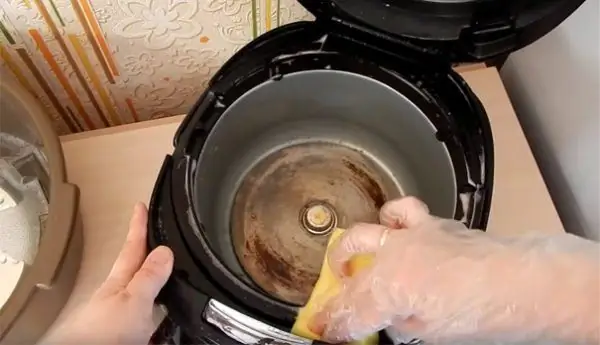
Do not leave carbon deposits on the heating element, as this disrupts heat transfer in the multicooker
Burnt food particles can be seen at the bottom of the bowl. Pour warm water into a bowl and add a few drops of dishwashing gel to it. Leave the bowl to “soak” for a few minutes, then wash it in warm water as usual. You may need to rub a little with a soft sponge to peel off burnt food, but never use anything hard - ruin the non-stick coating.
How not to do
On the Internet you can find many different "recipes" for the care of multicooker, but not all of them are effective and safe. The most common mistakes when caring for a multicooker:
- using soda as a detergent; soda is an abrasive material, although it is very gentle on various surfaces, so its small granules can scratch the non-stick coating of the bowl and ruin it;
- use of solvents; solvents very quickly deal with various types of contamination, but they damage the material of the multicooker components;
- using laundry soap as a detergent; multicooker parts are made of aluminum, which has a special protective film, when interacting with alkali, this film is completely destroyed, and aluminum can literally fall apart from contact with water.
How to get rid of odors
During cooking, a wide variety of aromas arise - sometimes pleasant and sometimes not very pleasant. In an amicable way, the slow cooker should not smell anything, since mixing aromas can give an unpleasant result, especially if a dish is saturated with this smell.
Plastic
All kitchen appliances have one feature - for the first few days of work, they "exude" a disgusting plastic smell. It literally lasts for the first 2-3 days of the equipment operation, which you just need to wait. However, this smell is not absorbed into the food, and the food has its own natural aroma.
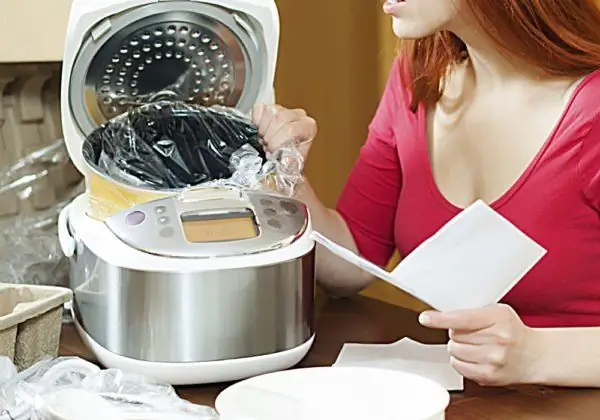
The first days of using any kitchen appliances are accompanied by the smell of plastic; if it seems too intrusive to you, pour water into the multicooker and bring it to a boil - the smell should disappear
Rotten meat
To combat the intolerable smell of rotten meat, use 6-9 percent table vinegar. As they say, a wedge knocks out a wedge. Soak a dry cloth in vinegar and wipe the multicooker completely, then leave it open for 30-40 minutes to let the vinegar smell disappear.
Mixing odors or aroma of spices
If it is not possible to get rid of odors for a long time, they mix, which is sometimes very inappropriate. To do this, you can simply thoroughly wash the entire multicooker or, if this does not help, pour a liter of plain water into the bowl and add lemon sliced into slices. It is necessary to set the operation mode of the multicooker "steam" for 20-30 minutes, then pour out the water with lemon, and wash the multicooker thoroughly with the product. After this procedure, no odors will remain.
Ground coffee is another means of combating foreign odors. Pour a few dessert spoons of ground coffee into a dry bowl and close the lid of the multicooker tightly. Leave the unit for 6-10 hours. During this time, coffee will absorb the smells, then it must be thrown away, and the bowl should be rinsed with warm water.
Reviews
The multicooker is an indispensable assistant in the kitchen of any housewife who will serve faithfully and cook amazing dishes if the rules for caring for the unit are followed. If something does not wash off or the unpleasant smell does not disappear, do not panic, otherwise you may lose your kitchen assistant by careless actions.
Recommended:
How To Get Rid Of Rats In A Private House, Chicken Coop, Apartment And Other Premises - Using Various Methods To Get Rid Of Rodents

Reasons for the appearance of rats in the house. What methods, means to use in the fight against rats in various residential and non-residential premises. Preventive actions. Video
How To Clean The Hood In The Kitchen From Fat, As Well As The Mesh And Its Other Parts, Using Various Methods And Means

We clean the hood in the kitchen and its other parts from grease and dirt: what tools and methods to use, especially for different materials, what is prohibited
How To Get Rid Of The Smell In The Refrigerator: Effective Ways To Remove The Smell Of Fish, Mold, Including Quick + Photos And Videos
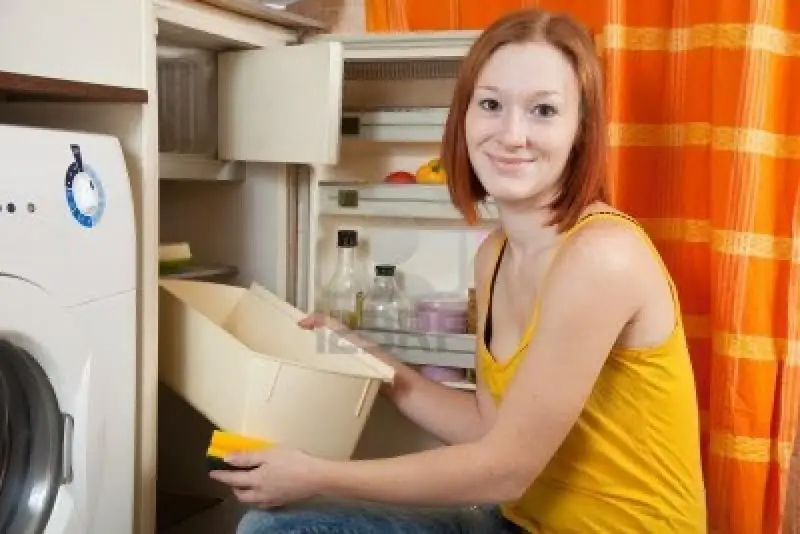
How to get rid of an unpleasant smell inside the refrigerator. Effective ways and means of combating stubborn odors. Tips from experienced housewives
How To Get Rid Of The Smell In The Closet, Including Clothes, How To Wash It So That It Doesn't Smell Musty

Is it possible to get rid of the smell in an old or new closet. Reasons for the appearance and remedies. What to do with things after disinfection
How To Remove The Smell Of Sweat From Clothes, Including Under The Armpits, How To Get Rid Of It And How To Remove It From A Leather Jacket, Jacket And Other Things

How to remove the smell of sweat from clothes made of different fabrics using traditional methods and industrial means. Instructions. Video
